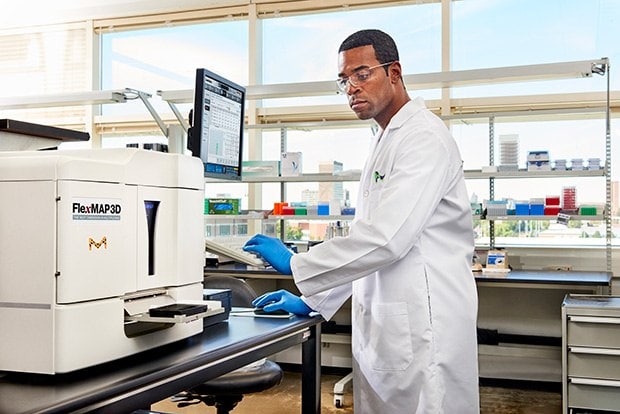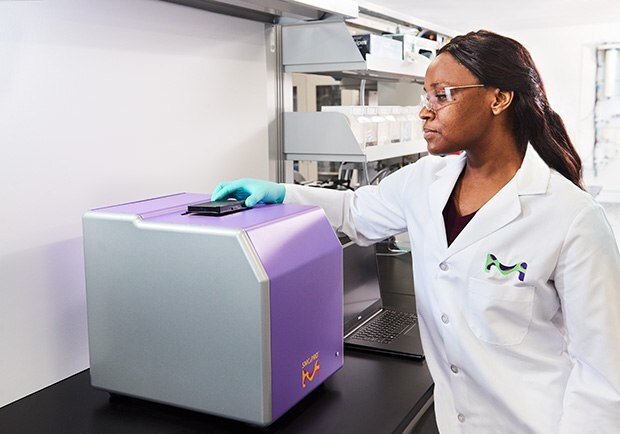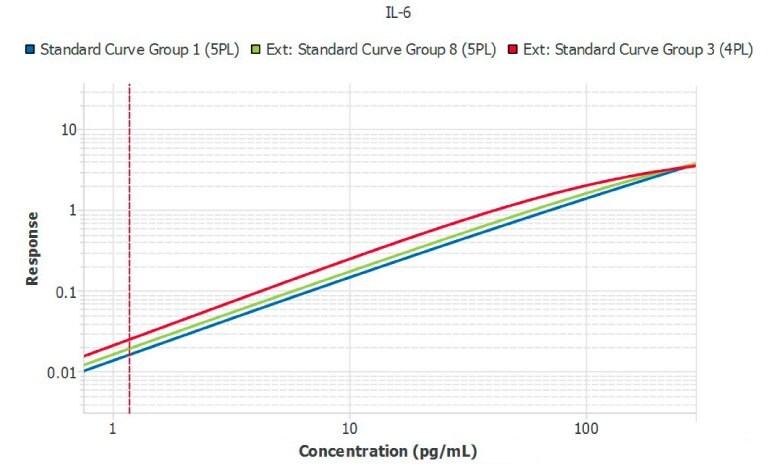Immunoassays for Cosmetics and Personal Care Research

With the growing popularity of cosmetics and personal care products, research around the safety of these products is critical. Immunoassays can be used in cosmetics and personal care research to assess biomarkers of inflammation, irritation, and more to find potential harmful effects of cosmetics.
The Skin Environment
The skin environment is the central focus of research on cosmetics and personal care products. The skin is the largest organ in the body, with such diverse functions as providing a mechanical barrier, thermoregulation, vitamin D synthesis, vitamin B folate protection, fluid homeostasis, sensation, and innate immunity. The skin responds to damage by upregulating repair mechanisms and causing skin cell hyperproliferation. Consequently, analysis of biochemical components from the stratum corneum (SC) can be used to evaluate skin irritation, SC integrity, and structure and inflammatory changes in human skin.
Research Cosmetics and Personal Care Product Effects with Immunoassays
“Clean” cosmetics have become a hot topic in cosmetics research due to the growing concerns around the toxicology of cosmetics and the potential harmful effects of cosmetics. Biomarker immunoassays help cosmetics and personal care researchers characterize the interactions between a biological system and a potential hazard. Immunoassays allow direct monitoring research on the biological effects of cosmetic products by assessing markers of inflammation, sensitization, aging, and tissue regeneration among others.
These immunoassays can include:
- Multiplex immunoassays
- Ultrasensitive immunoassays
- ELISAs
Multiplex Immunoassays
Multiplex immunoassays are used in cosmetics and personal care research to analyze multiple biomarkers simultaneously. This includes analytes relating to the skin, MMPs and TIMPs, aging, cytokines, chemokines, growth factors, steroid/thyroid/pituitary hormones, and immunoglobulin isotyping.
Based on the Luminex® xMAP® platform, high-quality MILLIPLEX® multiplex assays can assist researchers with their analysis of these biomarkers while saving time and sample volume. Below describes specific research applications of MILLIPLEX® panels.

Figure 1.MILLIPLEX® multiplex biomarker analysis.
Human Skin Biomarkers
More sensitive than clinical observation in its ability to detect subtle, treatment-induced changes in SC structural integrity, the MILLIPLEX® Human Skin Panel can analyze analyte concentrations in skin cell extracts or skin samples collected with a non-invasive tape absorption technique. This panel helps you simultaneously quantitate biomarkers for the functional study of the dermis and its sublayers. Table 1 describes a sample preparation technique for skin extract samples that can be analyzed with this panel.
MMPs and TIMPs
The matrix metalloproteinases (MMPs) play a key role in normal physiological processes, such as embryonic development and tissue morphogenesis, tissue and bone remodeling, wound healing, and angiogenesis. An increase in MMP expression occurs in response to a wide range of stimuli, including adhesion molecules, growth factors, cytokines, and hormones.
The regulation of MMP activity is controlled primarily by tissue inhibitors of metalloproteinases (TIMPs). TIMPs also exhibit several other biochemical and physiological/biological functions such as proMMP activation, cell growth promotion, matrix binding, inhibition of angiogenesis, and the induction of apoptosis.
The MILLIPLEX® MMP and TIMP panels detect the analytes in question to help monitor these physiological processes.
Materials
Aging Biomarkers
The MILLIPLEX® Human Aging Panel 1 covers multifaceted biomarkers of aging-related conditions. Monitoring these novel biomarkers helps researchers understand the basic mechanisms that drive aging and eventually lead to improved clinical interventions for extending the human healthspan.
Mice are widely used models for both aging and senescence because of their similarity to humans. Aging-associated physiological changes and the pathological consequences of these changes make the elderly population vulnerable to many chronic diseases, such as cancer, heart disease, arthritis, osteoporosis, and cognitive decline. Many of these conditions have been modeled in mice. Over the years, intensive research of model organisms has provided fundamental evidence that aging can be delayed, and longevity extended. These findings gave rise to a new era in aging research aiming to elucidate the underlying mechanisms that drive the aging process.
The MILLIPLEX® Mouse Aging Panel 1 covers biomarkers of aging-related conditions. Monitoring these biomarkers helps researchers understand the complex biological process which may lead to new therapies postponing age-related diseases.
Cytokines, Chemokines, and Growth Factors
Cytokines are immunomodulatory polypeptides that play key roles in both adaptive and innate immune responses. These proteins also mediate direct interactions between cells and regulate processes taking place in the extracellular environment. Growth factors are involved in the stimulation of target cell survival, proliferation, and differentiation with effects on angiogenesis, vasculogenesis, cell migration, apoptosis, wound healing, and embryogenesis. Angiogenesis, the development of new vascular networks, is a key process in normal growth and development as well as in wound healing.
The transforming growth factor beta (TGFβ) system, a superfamily of cytokines as well as signaling pathways, functions in immune cell development, angiogenesis, wound healing, embryonic development, and bone development.
All of the MILLIPLEX® panels for these cytokines, chemokines, and growth factors can be used to help researchers better understand the signaling pathways and immune responses related to their research.
Materials
Steroid, Thyroid, and Pituitary Hormones
Steroid and thyroid hormones play key roles in the regulation of energy balance, mental and physical development, sex organ development, reproduction, and pregnancy. The MILLIPLEX® Multi-Species Hormone Panel allows the study of the biological functions of hormones in the reproductive cycle and in the pathophysiology of many diseases. This assay is a valuable tool for research on endocrine-disrupting chemicals.
Called the “master gland” because it controls many other endocrine glands, the pituitary gland secretes several key hormones that play important roles in the regulation of metabolism, growth, and reproduction. The MILLIPLEX® Rat Pituitary Magnetic Bead Panel is used for the simultaneous quantification of 7 rat pituitary hormones.
Immunoglobulin Isotyping
Found only in mammals, Immunoglobulin E (IgE) plays an essential role in allergic reactions, and is predominantly associated with type 1 hypersensitivity. IgE binds with high affinity to the receptor FcεRI, found primarily on mast cells and basophils, priming the cells to recognize specific antigens such as dust mites, pet dander, or pollen. Once primed and with repeated exposure to the same antigen, these cells release molecules such as histamines, prostaglandins, and leukotrienes, resulting in an “allergic reaction”. The MILLIPLEX® Human and Mouse IgE Singleplex Kits allow for monitoring of IgE levels and possible allergic reactions.
Don’t see what you need? Develop a new assay or customize an assay by contacting our expert Custom Protein Immunoassay and Biomarker Development Services team.
For Research Use Only. Not For Use In Diagnostic Procedures.
Ultrasensitive Immunoassays
From inflammatory cytokines to dermal-specific proteins, researchers in the cosmetics and personal care product industry study biomarkers as molecular indicators of product safety and efficacy. The ultrasensitive Single Molecule Counting (SMC®) technology can contribute to these efforts by improving the study of early and low dose adverse effects from products, as well as more thoroughly tracking the downregulation of inflammatory biomarkers to evaluate product efficacy.
Ultrasensitive SMC® technology can help you increase the value of your key protein biomarker studies, featuring an easy-to-use instrument platform, a menu of highly verified shelf assay kits, compatible with a variety of sample types, and comprehensive sample testing and custom assay development services based on your exact biomarker needs.

Figure 2.Analysis with ultrasensitive Single Molecule Counting (SMC®) technology on the SMCxPRO® platform.
Materials
For Research Use Only. Not For Use In Diagnostic Procedures.
Enzyme-Linked Immunosorbent Assays (ELISAs)
ELISAs can be used in cosmetics research to analyze immune biomarkers and research any potential inflammatory processes from cosmetics or personal care products. Lot-to-lot consistency is crucial in this research where longitudinal studies are needed to investigate the long-term effects of cosmetics, as well as to perform research and development of new products.
The CONFERMA™ ELISAs are a range of products designed to address lot-to-lot variability within immunoassays. Each assay uses a pair of monoclonal antibodies (mAbs) and a recombinant protein calibrator (standard and quality control) developed in-house. The reagents undergo significant physiochemical characterization to confirm their lot-to-lot consistency, in R&D and throughout the lifetime of the product (Table 2).
Applying these techniques allows for monitoring of the individual reagents, as well as confirming their relationship batch-to-batch against the calibrator material. Each lot of finished kits is evaluated against the previous batch using both a sample QC library and a comparison of the mathematical parallelism of the standard curves. Together, these tests ensure that the inter-assay variability continues to fall within the parameters established at the launch of the product.
CONFERMA™ ELISAs can test cytokines which are markers often used by a laboratory over a long period, either as part of a longitudinal study or as a standard investigational tool. In either case, the CONFERMA™ ELISA process will ensure consistent and reproducible performance (Figure 3).

Figure 3.Mathematical parallelism of contrasted standard curves from individual plates of three lots of IL-6 ELISAs run by the same analyst. Lot 1 (blue line) was used as the reference curve for Lot 2 (green line) and Lot 3 (red line). Using Lot 1 as a reference, the slope ratio of Lots 2 and 3 was less than 0.1 indicating excellent similarity.
Materials
For Research Use Only. Not For Use In Diagnostic Procedures.
Highlighted Publications
See how our immunoassays are being used in cosmetics and personal care research.
MILLIPLEX® Panels
- Yegorov S, et al. Psoriasis Is Associated with Elevated Gut IL-1α and Intestinal Microbiome Alterations. Front Immunol. 2020. https://doi.org/10.3389/fimmu.2020.571319
- González-López MA, et al. Circulating levels of adiponectin, leptin, resistin and visfatin in nondiabetics patients with hidradenitis suppurativa. Arch Dermatol Res. 2020. https://doi.org/10.1007/s00403-019-02018-4
- Lee, JK, et al. Para-phenylenediamine, an oxidative hair dye ingredient, increases thymic stromal lymphopoietin and proinflammatory cytokines causing acute dermatitis. Toxicol Res. 2020. https://doi.org/10.1007/s43188-020-00041-6
- Fusco L, et al. Impact of the surface functionalization on nanodiamond biocompatibility: a comprehensive view on human blood immune cells. Carbon. 2019. https://doi.org/10.1016/j.carbon.2020.01.003
- Westman M, et al. In Vivo Cosmetic Product Efficacy Testing by Analyzing Epidermal Proteins Extracted from Tape Strips. Cosmetics. 2014. https://doi.org/10.3390/cosmetics1010029
- Kerr K, et al. Epidermal changes associated with symptomatic resolution of dandruff: biomarkers of scalp health. 2010. https://doi.org/10.1111/j.1365-4632.2010.04629.x
SMC® Kits
- Stober B, et al. Apremilast mechanism of efficacy in systemic-naive patients with moderate plaque psoriasis: Pharmacodynamic results from the UNVEIL study. J Dermatol Sci. 2019. https://doi.org/10.1016/j.jdermsci.2019.09.003
- Tomalin LE, et al. Early quantification of systemic inflammatory proteins predicts long-term treatment response to Tofacitinib and Etanercept. J Invest Dermatol. 2019. https://doi.org/10.1016/j.jid.2019.09.023
- Gordon KB, et al. Guselkumab efficacy after withdrawal is associated with suppression of serum IL-23-regulated IL-17 and IL-22 in psoriasis: VOYAGE 2 study. J Invest Dermatol. 2019. https://doi.org/10.1016/j.jid.2019.05.016
- Bruin G, et al. Secukinumab Treatment Does Not Alter the Pharmacokinetics of the Cytochrome P450 3A4 Substrate Midazolam in Patients with Moderate to Severe Psoriasis. Clin Pharmacol Ther. 2019. https://doi.org/10.1002/cpt.1558
- Wen HC, et al. Serum from Asian patients with atopic dermatitis is characterized by T H 2/T H 22 activation, which is highly correlated with nonlesional skin. J Allergy Clin Immunol. 2018. https://doi.org/10.1016/j.jaci.2018.02.047
- Song T, et al. An integrated model of alopecia areata biomarkers highlights both TH1 and TH2 upregulation. J Allergy Clin Immunol. 2018. https://doi.org/10.1016/j.jaci.2018.06.029
- Ungar B, et al. An Integrated Model of Atopic Dermatitis Biomarkers Highlights the Systemic Nature of the Disease. J Invest Dermatol. 2017. https://doi.org/10.1016/j.jid.2016.09.037
For Research Use Only. Not For Use In Diagnostic Procedures.
如要继续阅读,请登录或创建帐户。
暂无帐户?